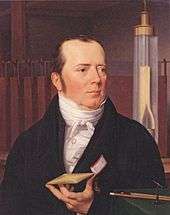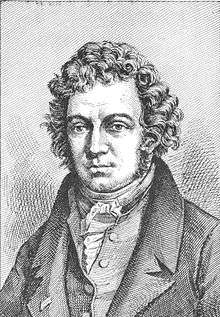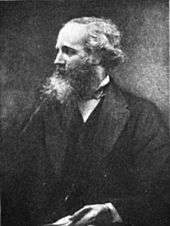Electromagnetism
Electromagnetism is a branch of physics involving the study of the electromagnetic force, a type of physical interaction that occurs between electrically charged particles. The electromagnetic force is carried by electromagnetic fields composed of electric fields and magnetic fields, and it is responsible for electromagnetic radiation such as light. It is one of the four fundamental interactions (commonly called forces) in nature, together with the strong interaction, the weak interaction, and gravitation.[1] At high energy the weak force and electromagnetic force are unified as a single electroweak force.

Electromagnetic phenomena are defined in terms of the electromagnetic force, sometimes called the Lorentz force, which includes both electricity and magnetism as different manifestations of the same phenomenon. The electromagnetic force plays a major role in determining the internal properties of most objects encountered in daily life. The electromagnetic attraction between atomic nuclei and their orbital electrons holds atoms together. Electromagnetic forces are responsible for the chemical bonds between atoms which create molecules, and intermolecular forces. The electromagnetic force governs all chemical processes, which arise from interactions between the electrons of neighboring atoms.
There are numerous mathematical descriptions of the electromagnetic field. In classical electrodynamics, electric fields are described as electric potential and electric current. In Faraday's law, magnetic fields are associated with electromagnetic induction and magnetism, and Maxwell's equations describe how electric and magnetic fields are generated and altered by each other and by charges and currents.
The theoretical implications of electromagnetism, particularly the establishment of the speed of light based on properties of the "medium" of propagation (permeability and permittivity), led to the development of special relativity by Albert Einstein in 1905.
History of the theory
Originally, electricity and magnetism were considered to be two separate forces. This view changed with the publication of James Clerk Maxwell's 1873 A Treatise on Electricity and Magnetism in which the interactions of positive and negative charges were shown to be mediated by one force. There are four main effects resulting from these interactions, all of which have been clearly demonstrated by experiments:
- Electric charges attract or repel one another with a force inversely proportional to the square of the distance between them: unlike charges attract, like ones repel.
- Magnetic poles (or states of polarization at individual points) attract or repel one another in a manner similar to positive and negative charges and always exist as pairs: every north pole is yoked to a south pole.
- An electric current inside a wire creates a corresponding circumferential magnetic field outside the wire. Its direction (clockwise or counter-clockwise) depends on the direction of the current in the wire.
- A current is induced in a loop of wire when it is moved toward or away from a magnetic field, or a magnet is moved towards or away from it; the direction of current depends on that of the movement.
While preparing for an evening lecture on 21 April 1820, Hans Christian Ørsted made a surprising observation. As he was setting up his materials, he noticed a compass needle deflected away from magnetic north when the electric current from the battery he was using was switched on and off. This deflection convinced him that magnetic fields radiate from all sides of a wire carrying an electric current, just as light and heat do, and that it confirmed a direct relationship between electricity and magnetism.
At the time of discovery, Ørsted did not suggest any satisfactory explanation of the phenomenon, nor did he try to represent the phenomenon in a mathematical framework. However, three months later he began more intensive investigations. Soon thereafter he published his findings, proving that an electric current produces a magnetic field as it flows through a wire. The CGS unit of magnetic induction (oersted) is named in honor of his contributions to the field of electromagnetism.
His findings resulted in intensive research throughout the scientific community in electrodynamics. They influenced French physicist André-Marie Ampère's developments of a single mathematical form to represent the magnetic forces between current-carrying conductors. Ørsted's discovery also represented a major step toward a unified concept of energy.
This unification, which was observed by Michael Faraday, extended by James Clerk Maxwell, and partially reformulated by Oliver Heaviside and Heinrich Hertz, is one of the key accomplishments of 19th-century mathematical physics.[2] It has had far-reaching consequences, one of which was the understanding of the nature of light. Unlike what was proposed by the electromagnetic theory of that time, light and other electromagnetic waves are at present seen as taking the form of quantized, self-propagating oscillatory electromagnetic field disturbances called photons. Different frequencies of oscillation give rise to the different forms of electromagnetic radiation, from radio waves at the lowest frequencies, to visible light at intermediate frequencies, to gamma rays at the highest frequencies.
Ørsted was not the only person to examine the relationship between electricity and magnetism. In 1802, Gian Domenico Romagnosi, an Italian legal scholar, deflected a magnetic needle using a Voltaic pile. The factual setup of the experiment is not completely clear, so if current flowed across the needle or not. An account of the discovery was published in 1802 in an Italian newspaper, but it was largely overlooked by the contemporary scientific community, because Romagnosi seemingly did not belong to this community.[3]
An earlier (1735), and often neglected, connection between electricity and magnetism was reported by a Dr. Cookson.[4] The account stated:
A tradesman at Wakefield in Yorkshire, having put up a great number of knives and forks in a large box ... and having placed the box in the corner of a large room, there happened a sudden storm of thunder, lightning, &c. ... The owner emptying the box on a counter where some nails lay, the persons who took up the knives, that lay on the nails, observed that the knives took up the nails. On this the whole number was tried, and found to do the same, and that, to such a degree as to take up large nails, packing needles, and other iron things of considerable weight ...
E. T. Whittaker suggested in 1910 that this particular event was responsible for lightning to be "credited with the power of magnetizing steel; and it was doubtless this which led Franklin in 1751 to attempt to magnetize a sewing-needle by means of the discharge of Leyden jars." [5]
Fundamental forces
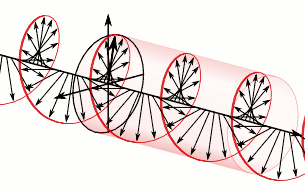
The electromagnetic force is one of the four known fundamental forces. The other fundamental forces are:
- the weak nuclear force, which binds to all known particles in the Standard Model, and causes certain forms of radioactive decay. (In particle physics though, the electroweak interaction is the unified description of two of the four known fundamental interactions of nature: electromagnetism and the weak interaction);
- the strong nuclear force, which binds quarks to form nucleons, and binds nucleons to form nuclei
- the gravitational force.
All other forces (e.g., friction, contact forces) are derived from these four fundamental forces.[6]
The electromagnetic force is responsible for practically all phenomena one encounters in daily life above the nuclear scale, with the exception of gravity. Roughly speaking, all the forces involved in interactions between atoms can be explained by the electromagnetic force acting between the electrically charged atomic nuclei and electrons of the atoms. Electromagnetic forces also explain how these particles carry momentum by their movement. This includes the forces we experience in "pushing" or "pulling" ordinary material objects, which result from the intermolecular forces that act between the individual molecules in our bodies and those in the objects. The electromagnetic force is also involved in all forms of chemical phenomena.
A necessary part of understanding the intra-atomic and intermolecular forces is the effective force generated by the momentum of the electrons' movement, such that as electrons move between interacting atoms they carry momentum with them. As a collection of electrons becomes more confined, their minimum momentum necessarily increases due to the Pauli exclusion principle. The behaviour of matter at the molecular scale including its density is determined by the balance between the electromagnetic force and the force generated by the exchange of momentum carried by the electrons themselves.[7]
Classical electrodynamics
In 1600, William Gilbert proposed, in his De Magnete, that electricity and magnetism, while both capable of causing attraction and repulsion of objects, were distinct effects. Mariners had noticed that lightning strikes had the ability to disturb a compass needle. The link between lightning and electricity was not confirmed until Benjamin Franklin's proposed experiments in 1752. One of the first to discover and publish a link between man-made electric current and magnetism was Romagnosi, who in 1802 noticed that connecting a wire across a voltaic pile deflected a nearby compass needle. However, the effect did not become widely known until 1820, when Ørsted performed a similar experiment.[8] Ørsted's work influenced Ampère to produce a theory of electromagnetism that set the subject on a mathematical foundation.
A theory of electromagnetism, known as classical electromagnetism, was developed by various physicists during the period between 1820 and 1873 when it culminated in the publication of a treatise by James Clerk Maxwell, which unified the preceding developments into a single theory and discovered the electromagnetic nature of light.[9] In classical electromagnetism, the behavior of the electromagnetic field is described by a set of equations known as Maxwell's equations, and the electromagnetic force is given by the Lorentz force law.[10]
One of the peculiarities of classical electromagnetism is that it is difficult to reconcile with classical mechanics, but it is compatible with special relativity. According to Maxwell's equations, the speed of light in a vacuum is a universal constant that is dependent only on the electrical permittivity and magnetic permeability of free space. This violates Galilean invariance, a long-standing cornerstone of classical mechanics. One way to reconcile the two theories (electromagnetism and classical mechanics) is to assume the existence of a luminiferous aether through which the light propagates. However, subsequent experimental efforts failed to detect the presence of the aether. After important contributions of Hendrik Lorentz and Henri Poincaré, in 1905, Albert Einstein solved the problem with the introduction of special relativity, which replaced classical kinematics with a new theory of kinematics compatible with classical electromagnetism. (For more information, see History of special relativity.)
In addition, relativity theory implies that in moving frames of reference, a magnetic field transforms to a field with a nonzero electric component and conversely, a moving electric field transforms to a nonzero magnetic component, thus firmly showing that the phenomena are two sides of the same coin. Hence the term "electromagnetism". (For more information, see Classical electromagnetism and special relativity and Covariant formulation of classical electromagnetism.)
Extension to nonlinear phenomena
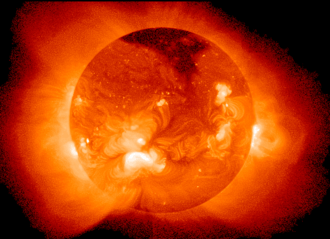
The Maxwell equations are linear, in that a change in the sources (the charges and currents) results in a proportional change of the fields. Nonlinear dynamics can occur when electromagnetic fields couple to matter that follows nonlinear dynamical laws. This is studied, for example, in the subject of magnetohydrodynamics, which combines Maxwell theory with the Navier–Stokes equations.
Quantities and units
Electromagnetic units are part of a system of electrical units based primarily upon the magnetic properties of electric currents, the fundamental SI unit being the ampere. The units are:
In the electromagnetic cgs system, electric current is a fundamental quantity defined via Ampère's law and takes the permeability as a dimensionless quantity (relative permeability) whose value in a vacuum is unity. As a consequence, the square of the speed of light appears explicitly in some of the equations interrelating quantities in this system.
SI electromagnetism units | ||||
|---|---|---|---|---|
| Symbol[11] | Name of quantity | Unit name | Symbol | Base units |
| Q | electric charge | coulomb | C | A⋅s |
| I | electric current | ampere | A | A (= W/V = C/s) |
| J | electric current density | ampere per square metre | A/m2 | A⋅m−2 |
| U, ΔV, Δφ; E | potential difference; electromotive force | volt | V | J/C = kg⋅m2⋅s−3⋅A−1 |
| R; Z; X | electric resistance; impedance; reactance | ohm | Ω | V/A = kg⋅m2⋅s−3⋅A−2 |
| ρ | resistivity | ohm metre | Ω⋅m | kg⋅m3⋅s−3⋅A−2 |
| P | electric power | watt | W | V⋅A = kg⋅m2⋅s−3 |
| C | capacitance | farad | F | C/V = kg−1⋅m−2⋅A2⋅s4 |
| ΦE | electric flux | volt metre | V⋅m | kg⋅m3⋅s−3⋅A−1 |
| E | electric field strength | volt per metre | V/m | N/C = kg⋅m⋅A−1⋅s−3 |
| D | electric displacement field | coulomb per square metre | C/m2 | A⋅s⋅m−2 |
| ε | permittivity | farad per metre | F/m | kg−1⋅m−3⋅A2⋅s4 |
| χe | electric susceptibility | (dimensionless) | 1 | 1 |
| G; Y; B | conductance; admittance; susceptance | siemens | S | Ω−1 = kg−1⋅m−2⋅s3⋅A2 |
| κ, γ, σ | conductivity | siemens per metre | S/m | kg−1⋅m−3⋅s3⋅A2 |
| B | magnetic flux density, magnetic induction | tesla | T | Wb/m2 = kg⋅s−2⋅A−1 = N⋅A−1⋅m−1 |
| Φ, ΦM, ΦB | magnetic flux | weber | Wb | V⋅s = kg⋅m2⋅s−2⋅A−1 |
| H | magnetic field strength | ampere per metre | A/m | A⋅m−1 |
| L, M | inductance | henry | H | Wb/A = V⋅s/A = kg⋅m2⋅s−2⋅A−2 |
| μ | permeability | henry per metre | H/m | kg⋅m⋅s−2⋅A−2 |
| χ | magnetic susceptibility | (dimensionless) | 1 | 1 |
Formulas for physical laws of electromagnetism (such as Maxwell's equations) need to be adjusted depending on what system of units one uses. This is because there is no one-to-one correspondence between electromagnetic units in SI and those in CGS, as is the case for mechanical units. Furthermore, within CGS, there are several plausible choices of electromagnetic units, leading to different unit "sub-systems", including Gaussian, "ESU", "EMU", and Heaviside–Lorentz. Among these choices, Gaussian units are the most common today, and in fact the phrase "CGS units" is often used to refer specifically to CGS-Gaussian units.
See also
- Abraham–Lorentz force
- Aeromagnetic surveys
- Computational electromagnetics
- Double-slit experiment
- Electromagnet
- Electromagnetic induction
- Electromagnetic wave equation
- Electromagnetic scattering
- Electromechanics
- Geophysics
- Introduction to electromagnetism
- Magnetostatics
- Magnetoquasistatic field
- Optics
- Relativistic electromagnetism
- Wheeler–Feynman absorber theory
References
- Ravaioli, Fawwaz T. Ulaby, Eric Michielssen, Umberto (2010). Fundamentals of applied electromagnetics (6th ed.). Boston: Prentice Hall. p. 13. ISBN 978-0-13-213931-1.
- Darrigol, Olivier (2000). Electrodynamics from Ampère to Einstein. New York: Oxford University Press. ISBN 0198505949.
- Martins, Roberto de Andrade. "Romagnosi and Volta's Pile: Early Difficulties in the Interpretation of Voltaic Electricity" (PDF). In Fabio Bevilacqua; Lucio Fregonese (eds.). Nuova Voltiana: Studies on Volta and his Times. 3. Università degli Studi di Pavia. pp. 81–102. Archived from the original (PDF) on 2013-05-30. Retrieved 2010-12-02.
- VIII. An account of an extraordinary effect of lightning in communicating magnetism. Communicated by Pierce Dod, M.D. F.R.S. from Dr. Cookson of Wakefield in Yorkshire. Phil. Trans. 1735 39, 74-75, published 1 January 1735
- Whittaker, E.T. (1910). A History of the Theories of Aether and Electricity from the Age of Descartes to the Close of the Nineteenth Century. Longmans, Green and Company.
- Browne, "Physics for Engineering and Science," p. 160: "Gravity is one of the fundamental forces of nature. The other forces such as friction, tension, and the normal force are derived from the electric force, another of the fundamental forces. Gravity is a rather weak force... The electric force between two protons is much stronger than the gravitational force between them."
- Purcell, "Electricity and Magnetism, 3rd Edition," p. 546: Ch 11 Section 6, "Electron Spin and Magnetic Moment."
- Stern, Dr. David P.; Peredo, Mauricio (2001-11-25). "Magnetic Fields – History". NASA Goddard Space Flight Center. Retrieved 2009-11-27.
- Purcell, p. 436. Chapter 9.3, "Maxwell's description of the electromagnetic field was essentially complete."
- Purcell: p. 278: Chapter 6.1, "Definition of the Magnetic Field." Lorentz force and force equation.
- International Union of Pure and Applied Chemistry (1993). Quantities, Units and Symbols in Physical Chemistry, 2nd edition, Oxford: Blackwell Science. ISBN 0-632-03583-8. pp. 14–15. Electronic version.
Further reading
Web sources
- Nave, R. "Electricity and magnetism". HyperPhysics. Georgia State University. Retrieved 2013-11-12.
- Khutoryansky, E. "Electromagnetism – Maxwell's Laws". Retrieved 2014-12-28.
Textbooks
- G.A.G. Bennet (1974). Electricity and Modern Physics (2nd ed.). Edward Arnold (UK). ISBN 978-0-7131-2459-0.
- Browne, Michael (2008). Physics for Engineering and Science (2nd ed.). McGraw-Hill/Schaum. ISBN 978-0-07-161399-6.
- Dibner, Bern (2012). Oersted and the discovery of electromagnetism. Literary Licensing, LLC. ISBN 978-1-258-33555-7.
- Durney, Carl H.; Johnson, Curtis C. (1969). Introduction to modern electromagnetics. McGraw-Hil]. ISBN 978-0-07-018388-9.
- Feynman, Richard P. (1970). The Feynman Lectures on Physics Vol II. Addison Wesley Longman. ISBN 978-0-201-02115-8.
- Fleisch, Daniel (2008). A Student's Guide to Maxwell's Equations. Cambridge, UK: Cambridge University Press. ISBN 978-0-521-70147-1.
- I.S. Grant; W.R. Phillips; Manchester Physics (2008). Electromagnetism (2nd ed.). John Wiley & Sons. ISBN 978-0-471-92712-9.
- Griffiths, David J. (1998). Introduction to Electrodynamics (3rd ed.). Prentice Hall. ISBN 978-0-13-805326-0.
- Jackson, John D. (1998). Classical Electrodynamics (3rd ed.). Wiley. ISBN 978-0-471-30932-1.
- Moliton, André (2007). Basic electromagnetism and materials. 430 pages. New York City: Springer-Verlag New York, LLC. ISBN 978-0-387-30284-3.
- Purcell, Edward M. (1985). Electricity and Magnetism Berkeley, Physics Course Volume 2 (2nd ed.). McGraw-Hill. ISBN 978-0-07-004908-6.
- Purcell, Edward M and Morin, David. (2013). Electricity and Magnetism, 820p (3rd ed.). Cambridge University Press, New York. ISBN 978-1-107-01402-2.CS1 maint: multiple names: authors list (link)
- Rao, Nannapaneni N. (1994). Elements of engineering electromagnetics (4th ed.). Prentice Hall. ISBN 978-0-13-948746-0.
- Rothwell, Edward J.; Cloud, Michael J. (2001). Electromagnetics. CRC Press. ISBN 978-0-8493-1397-4.
- Tipler, Paul (1998). Physics for Scientists and Engineers: Vol. 2: Light, Electricity and Magnetism (4th ed.). W.H. Freeman. ISBN 978-1-57259-492-0.
- Wangsness, Roald K.; Cloud, Michael J. (1986). Electromagnetic Fields (2nd Edition). Wiley. ISBN 978-0-471-81186-2.
General references
- A. Beiser (1987). Concepts of Modern Physics (4th ed.). McGraw-Hill (International). ISBN 978-0-07-100144-1.
- L.H. Greenberg (1978). Physics with Modern Applications. Holt-Saunders International W.B. Saunders and Co. ISBN 978-0-7216-4247-5.
- R.G. Lerner; G.L. Trigg (2005). Encyclopaedia of Physics (2nd ed.). VHC Publishers, Hans Warlimont, Springer. pp. 12–13. ISBN 978-0-07-025734-4.
- J.B. Marion; W.F. Hornyak (1984). Principles of Physics. Holt-Saunders International Saunders College. ISBN 978-4-8337-0195-2.
- H.J. Pain (1983). The Physics of Vibrations and Waves (3rd ed.). John Wiley & Sons. ISBN 978-0-471-90182-2.
- C.B. Parker (1994). McGraw Hill Encyclopaedia of Physics (2nd ed.). McGraw Hill. ISBN 978-0-07-051400-3.
- R. Penrose (2007). The Road to Reality. Vintage books. ISBN 978-0-679-77631-4.
- P.A. Tipler; G. Mosca (2008). Physics for Scientists and Engineers: With Modern Physics (6th ed.). W.H. Freeman and Co. ISBN 978-1-4292-0265-7.
- P.M. Whelan; M.J. Hodgeson (1978). Essential Principles of Physics (2nd ed.). John Murray. ISBN 978-0-7195-3382-2.
External links
| Wikiquote has quotations related to: Electromagnetism |
| Library resources about Electromagnetism |
- Magnetic Field Strength Converter
- Electromagnetic Force – from Eric Weisstein's World of Physics
- The Deflection of a Magnetic Compass Needle by a Current in a Wire (video) on YouTube

